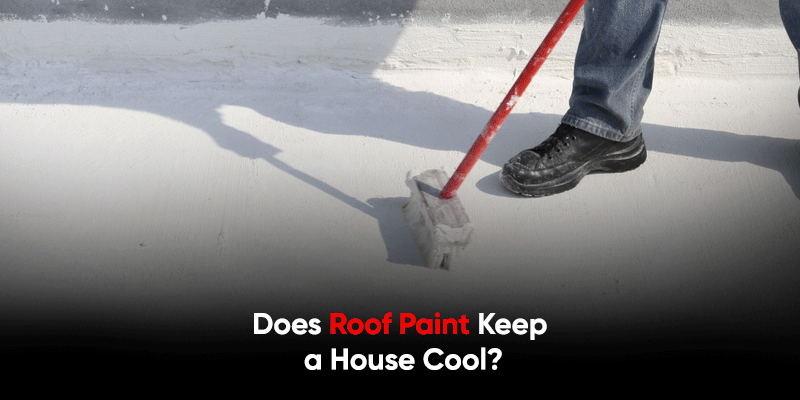
Does Roof Paint Keep a House Cool?
Scorching summers turn homes into ovens, making indoor spaces unbearable. The reason? Your roof absorbs heat, trapping it inside. Many rely on air conditioners, but skyrocketing electricity bills follow. What if there was a simpler, cost-effective fix?
Roof cooling paint is a game-changer in temperature control. This heat-reflective coating reduces heat absorption, keeping your home significantly cooler. But does it truly work? How effective is it in extreme climates?
This guide uncovers the science behind cool roof coatings, their benefits, and whether they’re the right solution for your home. Let’s explore how this innovative approach can transform indoor comfort.
How Roof Temperature Affects Indoor Cooling?
Your roof is the first line of defense against the sun, but it can also be the biggest reason your home feels like a furnace. During peak summer, rooftops can reach upto 60-70°C, radiating heat downwards and making rooms unbearably hot.
The type of roofing material plays a huge role in heat absorption. Metal roofs heat up quickly but cool down fast, while concrete roofs trap heat for longer, keeping interiors warm even at night. Dark-colored roofs absorb more heat than light ones, worsening the problem.
This is where roof cooling paint helps—by reflecting heat instead of absorbing it, keeping homes significantly cooler.
What is Cool Roof Paint?
Not all paints are designed to combat extreme heat. Cool paint for roof is a specialized coating that reflects sunlight and minimizes heat absorption, unlike regular paints that trap warmth.
Its effectiveness comes from two key properties: high solar reflectance (typically 60–90%) and strong thermal emittance (around 80–95%). Solar reflectance helps bounce back sunlight, reducing heat buildup, while thermal emittance allows the roof to release any absorbed heat quickly.
These coatings use reflective pigments, ceramic microspheres, and elastomeric polymers, making rooftops cooler and cutting down on air-conditioning costs—all while extending roof lifespan.
How Does Roof Paint Help in Cooling?
A hot roof means a hot home. Reflective roof coatings act as a barrier against heat, bouncing back a large portion of the sun’s radiation instead of allowing it to be absorbed. This helps lower roof surface temperatures and prevents excessive heat from seeping indoors, making rooms naturally cooler and reducing dependence on air conditioning.
Light-colored and specialized coatings are particularly effective in hot climates. Dark roofs absorb up to 90% of solar energy, while roof cooling paint with high solar reflectance (60–90%) and thermal emittance (80–95%) reflects more sunlight and releases stored heat faster. This significantly reduces indoor temperatures, enhancing overall comfort.
Several studies highlight the impact of cool roof coatings. Research by the U.S. Department of Energy found that such coatings can lower roof temperatures by up to 30°C, translating to an indoor heat reduction of 20–30%. Additionally, a study by the Heat Island Group shows that cool roofs can cut cooling energy use by 10-30%, leading to substantial electricity savings.
Beyond cooling benefits, some of these coatings also help protect the roof from wear and tear, extending its lifespan by reducing thermal stress. By investing in cool paint for the roof, homeowners can enjoy better indoor comfort, lower energy costs, and increased roof durability.
Benefits of Using Cool Roof Paint
Applying cool paint to a roof is more than just a heat-fighting measure—it’s a smart investment with multiple advantages. Here’s how it makes a difference:
- Lowers Indoor Temperature: By reflecting 60-90% of sunlight, cool roof coatings prevent excessive heat buildup. This keeps indoor spaces 2–5°C cooler, reducing discomfort during peak summer months.
- Reduces Air Conditioning Costs: With a cooler home, the need for air conditioning drops significantly. Studies show that cool roofs can cut cooling energy consumption by 10–30%, leading to lower electricity bills.
- Extends Roof Lifespan: Heat fluctuations cause thermal stress, leading to cracks and deterioration. Heat-reflective coatings protect roofing materials, reducing wear and extending the roof’s durability.
- Eco-Friendly Solution: By lowering energy usage, cool roof paint reduces carbon footprints. It also combats the urban heat island effect, where cities become significantly hotter due to heat-absorbing surfaces.
Switching to cool paint for the roof isn’t just about comfort—it’s about long-term savings, sustainability, and better living conditions.
Types of Cool Roof Paints
Choosing the right cool paint for the roof is essential for maximum cooling and durability. Different coatings offer varying levels of heat reflectivity and protection.
- Reflective Coatings: These coatings are designed to bounce back sunlight and prevent heat buildup. Common types include:
- Acrylic Coatings—Cost-effective and water-resistant but may wear out faster.
- Elastomeric Coatings—Stretchable and durable, providing extra protection against cracks.
- Silicone Coatings—Highly weather-resistant, ideal for heavy rains and extreme heat.
- White vs. Tinted Cool Roof Coatings
- White coatings reflect the most heat, reducing temperatures by up to 30°C.
- Tinted coatings (light gray, beige) offer moderate cooling but suit aesthetic preferences.
Considering intense heat, dust, and monsoons, elastomeric and silicone-based cool paints work best. They provide high solar reflectance while resisting dirt accumulation and rain damage.
Limitations and Considerations
While cool roof paint is highly effective, it’s not a magic solution. Here’s what to consider:
- Not a standalone cooling solution—though it lowers roof temperature, proper insulation and ventilation are still needed for complete indoor cooling.
- Effectiveness depends on roof type and location—works best on flat and metal roofs. Also, it may be less effective on high-pitched roofs or shaded areas.
- Initial Cost vs. Long-Term Savings—High-quality heat-reflective coatings can be expensive upfront but lead to 10–30% energy savings over time, making them a cost-effective investment.
Once you understand both benefits and limitations, as homeowners, you can make informed decisions about using cool paint for roofs for maximum comfort and efficiency.
Alternative Ways to Keep Your Roof Cool
While cool paint for roofs is an effective way to lower temperatures, combining it with other cooling techniques can enhance results. Here are additional ways to keep your roof and home cooler:
- Use heat-resistant roofing materials—materials like clay tiles, metal sheets with reflective coatings, and insulated concrete slabs absorb less heat compared to traditional dark-colored roofs.
- Install green roofs or rooftop gardens—growing plants on rooftops acts as a natural insulator, absorbing heat while cooling the surroundings through evapotranspiration (the process where plants release moisture into the air).
- Improve roof insulation and ventilation—adding thermal insulation layers beneath the roof prevents heat from transferring indoors, while proper attic ventilation helps release trapped hot air, maintaining a cooler indoor environment.
Conclusion
So, cool roof painting works—but with realistic expectations. It can lower roof temperature by up to 30°C, significantly reducing indoor heat. However, for extreme heat conditions, pairing it with roof insulation, ventilation, and reflective roofing materials will maximize cooling benefits.
For homeowners looking for a reliable, long-lasting solution, HeatCure’s advanced roof coating solutions offer superior heat resistance, durability, and energy savings. Designed for the Indian climate, HeatCure coatings provide maximum solar reflectance while withstanding dust, heavy rains, and temperature fluctuations.
Investing in HeatCure’s cool roof coatings means a cooler home, lower electricity bills, and a more sustainable future. Book your consultation now!



Comment (0)